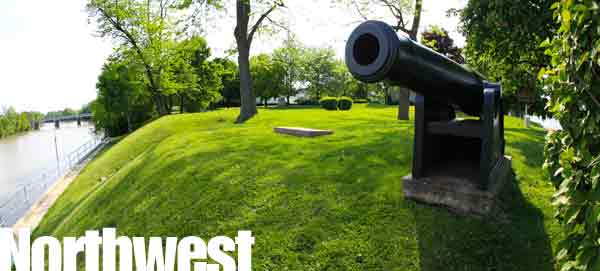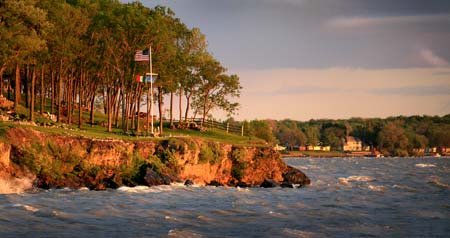When the first settlers came to Northwest Ohio, the flat expansive farm land that we know today, was mostly waist high weedy grass growing in a thick mucky swamp that was a breeding soup for disease carrying mosquitoes for much of the warmer months. It was not an easy area to travel even on horseback, much less put down roots except for the most adventuresome. In time though, the great Black Swamp and the areas surrounding it were drained and the extremely flat land became some of the richest farm land in the state.
The northwest is a still vital farmland, but it is also home to some of Ohio's most popular amusement parks, islands, caverns, and beach front property, which belies the major historical importance of the region and the critical role it played not only in our states development, but the shape our nation took during its early years.
North Coast Islands
The northwest is also home to Ohio's famous islands that have a long history and played an important role on the history of the state. On one of the islands there is an international monument recognizing the hard fought battles waged on Lake Erie and the lasting peace between two countries resulting from that conflict.
From laid back Kelley's Island to the raucous South Bass Island and its notorious Put-In-Bay Harbor, the North Coast Islands have something for everyone during the warmer days of summer: good food, great entertainment, and a place to escape
More about the North coast 
Oil Fields of the Northwest
The upper portion of Northwest Ohio is an extremely flat plain that was once the bottom of an ancient lake. South of this plain are gently rolling hills. These rolling hills are the results of millions of years of glacier advances and retreats leaving deposits from rocks and soil carried south from Canada as the glaciers melted. This area has one notable exception where a hilly belt of bedrock in Bellefontaine rises 1,549 feet above sea level -- the highest point in the state, called Campbell's Hill.
 When oil was discovered in the northwest, new industries sprang up in an area that was primarily an agricultural area. A number of the communities in northwest Ohio came to life because of abundant oil and gas and the industries they helped support. From the mid-1880s to the early 1900s, northwest Ohio lead the world in oil production. When oil was discovered near Grand Lake, the largest man-made lake in Ohio was dotted with oil platforms, becoming the first over-water drilling operation in the world.
When oil was discovered in the northwest, new industries sprang up in an area that was primarily an agricultural area. A number of the communities in northwest Ohio came to life because of abundant oil and gas and the industries they helped support. From the mid-1880s to the early 1900s, northwest Ohio lead the world in oil production. When oil was discovered near Grand Lake, the largest man-made lake in Ohio was dotted with oil platforms, becoming the first over-water drilling operation in the world.
 Neil Armstrong Air & Space Museum
Neil Armstrong Air & Space Museum
The Neil Armstrong Air and Space Museum, located just off I-75 in Auglaize County in Wapakoneta, is a treasure trove of memorabilia from the first man to set foot on the moon. But while Armstrong is the dominant figure, thanks to some recent renovations, many exhibits are designed to give visitors a better perspective on the history of space travel and the politically charged space race of the 1960s.
 Providence Metro Park
Providence Metro Park
Take a step back in time at Providence Metropark. The park features an operating 19th Century canal boat that you can take a trip down a portion of the Miami & Erie Canal.
One highlight of the trip is passing through one of the very few operating locks that were a common part of traveling by canal. Also in this authentic Metro Park is an operating mill used to produce flour and other ground goods as well as an operating saw mill, all powered by water.
 America's Kitchen
America's Kitchen
KitchenAide has long been an fixture in many American kitchens. Visit where these wonderful appliances are manufactured in historic Greenville.
More about KitchenAide Factory Tour in Greenville, Ohio 
Historic Northwest
Before settlers arrive, Native Americans mostly avoided the extreme northwest because of the swampy land and mosquito infestations made life almost during the hot summer months. Because of the areas strategic location, northwest Ohio played an important role during the War of 1812. General Harrison ordered a number of forts constructed to help defend the area from British coming around the western end of Lake Erie. He also rebuilt several forts that were used during the Indian Wars of the late 1700s.
 Fort Meigs
Fort Meigs
Fort Meigs, the largest reconstructed wooden fort in Ohio, includes 10 acres of land and has a mile perimeter overlooking the Maumee River. Fort Meigs stood as an important stronghold against the British during the War of 1812. In the 1960s the Ohio Historical Society purchased the site to rebuild the fort, and in 1974 the reconstructed fort was opened to the public.
See authentically dressed characters demonstrate important aspects of the fort. The Fort Meigs Museum offers an in depth experience of the activities of the fort as well as many artifacts recovered during the reconstruction.
Additional information about Ohio's northwest historic fortifications:
Treaty of Greenville's importance is recognized by a large painting hanging in the Statehouse.
Treaty of Greeneville: Beginning of the end for
Native Americans in Ohio
One of the most far reaching events that helped form Ohio was the signing of the Treaty of Greene Ville. This treaty provided an official document between many Native Americans and the United States government. Although there had been and would be many documents signed between the government and Native Americans, what makes this document unique to Ohio is that it created a somewhat lasting peace in the Ohio Territory, at least till the run up to the War of 1812. More significant was the divide this treaty created between the Native Americans.





